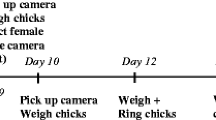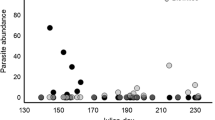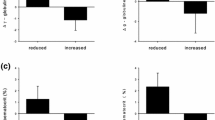Abstract
After birth, an organism needs to invest both in somatic growth and in the development of efficient immune functions to counter the effects of pathogens, and hence an investment trade-off is predicted. To explore this trade-off, we simultaneously exposed nestling great tits (Parus major) to a common ectoparasite, while stimulating immune function. Using a 2 × 2 experimental design, we first infested half of the nests with hen fleas (Ceratophyllus gallinae) on day 3 post-hatch and later, on day 9–13 post-hatch, and then supplemented half of the nestlings within each nest with an immuno-enhancing amino acid (methionine). We then assessed the non-specific immune response by measuring both the inflammatory response to a lipopolysaccharide (LPS) and assessing the levels of acute phase proteins (APP). In parasite-infested nestlings, methionine had a negative effect on body mass close to fledging. Methionine had an immune-enhancing effect in the absence of ectoparasites only. The inflammatory response to LPS was significantly lower in nestlings infested with fleas and was also lower in nestlings supplemented with methionine. These patterns of immune responses suggest an immunosuppressive effect of ectoparasites that could neutralise the immune-enhancing effect of methionine. Our study thus suggests that the trade-off between investment in life history traits and immune function is only partly dependent on available resources, but shows that parasites may influence this trade-off in a more complex way, by also inhibiting important physiological functions.



Similar content being viewed by others
References
Andrade BB, Texeira CR, Barral A, Barral-Netto M (2005) Haematophagous arthropod saliva and host defense system: a tale of tear and blood. An Acad Bras Cienc 77:665–693. doi:10.1590/S0001-37652005000400008
Barnes DM, Song Z, Klasing KC, Bottje W (2002) Protein metabolism during an acute phase response in chickens. Amino Acids 22:15–26. doi:10.1007/S726-002-8198-6
Bates D (2010) lme4: mixed-effects modeling with R. Springer, Berlin
Berthouly A, Cassier A, Richner H (2008) Carotenoid-induced maternal effects interact with ectoparasite burden and brood size to shape the trade-off between growth and immunity in nestling great tits. Funct Ecol 22:854–863. doi:10.1111/J.1365-2435.2008.01439.X
Bize P, Jeanneret C, Klopfenstein A, Roulin A (2008) What makes a host profitable? Parasites balance host nutritive resources against immunity. Am Nat 171:107–118. doi:10.1086/523943
Bize P, Piault R, Gasparini J, Roulin A (2010) Indirect costs of parasitism are shaped by variation in the type of immune challenge and food availability. Evol Biol 37:169–176. doi:10.1007/S11692-010-9092-5
Bonneaud C, et al. (2003) Assessing the cost of mounting an immune response. Am Nat 161:367–379
Boughton RK, Atwell JW, Schoech SJ (2006) An introduced generalist parasite, the sticktight flea (Echidnophaga gallinacea), and its pathology in the threatened Florida scrub-jay (Aphelocoma coerulescens). J Parasitol 92:941–948. doi:10.1645/Ge-769r.1
Boughton RK, Joop G, Armitage SAO (2011) Outdoor immunology: methodological considerations for ecologists. Funct Ecol 25:81–100. doi:10.1111/J.1365-2435.2010.01817.X
Box GEP, Cox DR (1964) An analysis of transformations. J R Stat Soc B 26:211–252
Brommer JE (2004) Immunocompetence and its costs during development: an experimental study in blue tit nestlings. Proc R Soc Lond Ser Biol Sci 271:S110–S113. doi:10.1098/rsbl.2003.0103
Brus I, Lewis SM (1959) The haptoglobin content of serum in haemolytic anaemia. Br J Haematol 5:348. doi:10.1111/J.1365-2141.1959.Tb04045.X
Buechler K, Fitze PS, Gottstein B, Jacot A, Richner H (2002) Parasite-induced maternal response in a natural bird population. J Anim Ecol 71:247–252. doi:10.1046/J.1365-2656.2002.00591.X
Clayton DH, Moore J (1997) Host–parasite evolution: general principles and avian models. Oxford University Press, Oxford
Coslovsky M, Richner H (2011) Increased predation risk on mothers affects survival of parasites feeding on the offspring. Anim Behav 81:1071–1075. doi:10.1016/J.Anbehav.02.023
Coslovsky M, Richner H (2012) An experimental test of predator-parasite interaction in a passerine bird. Oikos 121:1691–1701. doi:10.1111/J.1600-0706.2011.20290.X
De Coster G, De Neve L, Martin-Galvez D, Therry L, Lens L (2010) Variation in innate immunity in relation to ectoparasite load, age and season: a field experiment in great tits (Parus major). J Exp Biol 213:3012–3018. doi:10.1242/Jeb.042721
Dunn A, Wang J (1995) Cytokine effects on CNS biogenic amines. Neuroimmunomodulation 2:319–328
Elliot SL, Blanford S, Thomas MB (2002) Host-pathogen interactions in a varying environment: temperature, behavioural fever and fitness. Proc R Soc B Biol Sci 269:1599–1607. doi:10.1098/Rspb.2002.2067
Engqvist L (2005) The mistreatment of covariate interaction terms in linear model analyses of behavioural and evolutionary ecology studies. Anim Behav 70:967–971. doi:10.1016/J.Anbehav.2005.01.016
Gabay C (1999) Mechanisms of disease: acute-phase proteins and other systemic responses to inflammation. New Engl J Med 340:1376
Gabay C, Kushner I (1999) Mechanisms of disease: acute-phase proteins and other systemic responses to inflammation. New Engl J Med 340:448–454
Gallizzi K, Bischoff LL, Gern L, Richner H (2008) An experimental study on the influence of tick infestations on nestling performance in great tits (Parus major). Auk 125:915–922. doi:10.1525/Auk.2008.07175
Gasparini J, McCoy KD, Haussy C, Tveraa T, Boulinier T (2001) Induced maternal response to the Lyme disease spirochaete Borrelia burgdorferi sensu lato in a colonial seabird, the kittiwake Rissa tridactyla. Proc R Soc B Biol Sci 268:647–650
Gonzalez-Braojos S, Ruiz-de-Castaneda R, Moreno J (2013) No association between measures of immunity in nestling pied flycatchers (Ficedula hypoleuca). Ann Zool Fenn 50:279–288
Grimble RF (2006) The effects of sulfur amino acid intake on immune function in humans. J Nutr 136:1660S–1665S
Grimble RF, Grimble GK (1998) Immunonutrition: role of sulfur amino acids, related amino acids, and polyamines. Nutrition 14:605–610
Grindstaff JL, Hasselquist D, Nilsson JA, Sandell M, Smith HG, Stjernman M (2006) Transgenerational priming of immunity: maternal exposure to a bacterial antigen enhances offspring humoral immunity. Proc R Soc B Biol Sci 273:2551–2557. doi:10.1098/Rspb.2006.3608
Harrington DWJ, Robinson K, Sparagano OAE (2010) Immune responses of the domestic fowl to Dermanyssus gallinae under laboratory conditions. Parasitol Res 106:1425–1434. doi:10.1007/S00436-010-1821-2
Hasselquist D, Tobler M, Nilsson J-A (2011) Maternal modulation of offspring immune function in vertebrates. In: Demas GE, Nelson RJ (eds) Ecoimmunology. Oxford University Press, New York
Killpack TL, Karasov WH (2012) Ontogeny of adaptive antibody response to a model antigen in captive altricial zebra finches. PLoS One 7:e47294. doi:10.1371/journal.pone.0047294
King MO, Owen JP, Schwabl HG (2010) Are maternal antibodies really that important? Patterns in the immunologic development of altricial passerine house sparrows (Passer domesticus). PLoS One 5:e9639. doi:10.1371/journal.pone.0009639
Kuby J, Kindt TJ, Goldsby RA, Osborne BA (2007) Immunology. Freeman, New York
Losdat S, Helfenstein F, Gaude B, Richner H (2011) Reproductive effort transiently reduces antioxidant capacity in a wild bird. Behav Ecol 22:1218–1226. doi:10.1093/Beheco/Arr116
Matson KD, Cohen AA, Klasing KC, Ricklefs RE, Scheuerlein A (2006) No simple answers for ecological immunology: relationships among immune indices at the individual level break down at the species level in waterfowl. Proc R Soc B Biol Sci 273:815–822. doi:10.1098/Rspb.2005.3376
Millet S, Bennett J, Lee KA, Hau M, Klasing KC (2007) Quantifying and comparing constitutive immunity across avian species. Dev Comp Immunol 31:188–201. doi:10.1016/J.Dci.05.013
Norris K, Evans MR (2000) Ecological immunology: life history trade-offs and immune defense in birds. Behav Ecol 11:19–26
O’Brien EL, Dawson RD (2013) Nestling sex predicts susceptibility to parasitism and influences parasite population size within avian broods. J Avian Biol 44:226–234. doi:10.1111/J.1600-048x.2012.05802.X
Oppliger A, Richner H, Christe P (1994) Effect of an ectoparasite on lay date, nest-site choice, desertion, and hatching success in the great tit (Parus major). Behav Ecol 5:130–134. doi:10.1093/Beheco/5.2.130
Owen JP, Delany ME, Cardona CJ, Bickford AA, Mullens BA (2009) Host inflammatory response governs fitness in an avian ectoparasite, the northern fowl mite (Ornithonyssus sylviarum). Int J Parasitol 39:789–799. doi:10.1016/j.ijpara.2008.12.008
Owen JP, Nelson AC, Clayton DH (2010) Ecological immunology of bird-ectoparasite systems. Trends Parasitol 26:530–539. doi:10.1016/j.pt.2010.06.005
Pamplona R, Barja G (2007) Highly resistant macromolecular components and low rate of generation of endogenous damage: two key traits of longevity. Ageing Res Rev 6:189–210. doi:10.1016/J.Arr.06.002
Parmentier HK, Reilingh GD, Nieuwland MGB (1998a) Kinetic and immunohistochemical characteristics of mitogen-induced cutaneous hypersensitivity in chickens selected for antibody responsiveness. Vet Immunol Immunopathol 66:367–376. doi:10.1016/S0165-2427(98)00200-1
Parmentier HK, Walraven M, Nieuwland MGB (1998b) Antibody responses and body weights of chicken lines selected for high and low humoral responsiveness to sheep red blood cells. 1. Effect of Escherichia coli lipopolysaccharide. Poult Sci 77:248–255
Petersen HH, Nielsen JP, Heegaard PMH (2004) Application of acute phase protein measurements in veterinary clinical chemistry. Vet Res 35:163–187. doi:10.1051/Vetres:2004002
Pihlaja M, Siitari H, Alatalo RV (2006) Maternal antibodies in a wild altricial bird: effects on offspring immunity, growth and survival. J Anim Ecol 75:1154–1164. doi:10.1111/J.1365-2656.2006.01136.X
Pinheiro J, Bates D, DebRoy S, Sarkar D (2012) R Development Core Team. nlme: linear and nonlinear mixed effects models
Pitala N, Siitari H, Gustafsson L, Brommer JE (2010) Costs and benefits of experimentally induced changes in the allocation of growth versus immune function under differential exposure to ectoparasites. PLoS One 5:e10814. doi:10.1371/journal.pone.0010814
R Core Team (2013) R: alanguage and environment for statistical computing. R Foundation for Statistical Computing, Vienna
Richner H, Oppliger A, Christe P (1993) Effect of an ectoparasite on reproduction in great tits. J Anim Ecol 62:703–710. doi:10.2307/5390
Rogerson S (2006) What is the relationship between haptoglobin, malaria, and anaemia? PLoS Med 3:593–594. doi:10.1371/journal.pmed.0030200
Schmid-Hempel P (2009) Immune defence, parasite evasion strategies and their relevance for ‘macroscopic phenomena’ such as virulence. Philos Trans R Soc Lond B Biol Sci 364:85–98. doi:10.1098/Rstb.2008.0157
Sol D, Jovani R, Torres J (2003) Parasite mediated mortality and host immune response explain age-related differences in blood parasitism in birds. Oecologia 135:542–547. doi:10.1007/S00442-003-1223-6
Soler JJ, de Neve L, Perez-Contreras T, Soler M, Sorci G (2003) Trade-off between immunocompetence and growth in magpies: an experimental study. R Soc Lond Ser B Biol Sci 270:241–248. doi:10.1098/Rspb.2002.2217
Sorci G, Faivre B (2009) Inflammation and oxidative stress in vertebrate host-parasite systems. Philos Trans R Soc Lond B Biol Sci 364:71–83. doi:10.1098/rstb.2008.0151
Stadtman ER, Moskovitz J, Levine RL (2003) Oxidation of methionine residues of proteins: biological consequences. Antioxid Redox Sign 5:577–582. doi:10.1089/152308603770310239
Suffredini AF, Fantuzzi G, Badolato R, Oppenheim JJ, O’Grady NP (1999) New insights into the biology of the acute phase response. J Clin Immunol 19:203–214. doi:10.1023/A:1020563913045
Tripet F, Richner H (1997) The coevolutionary potential of a ‘generalist’ parasite, the hen flea Ceratophyllus gallinae. Parasitology 115:419–427. doi:10.1017/S0031182097001467
Tschirren B, Richner H (2006) Parasites shape the optimal investment in immunity. Proc R Soc B Biol Sci 273:1773–1777. doi:10.1098/rspb.2006.3524
Tschirren B, Bischoff LL, Saladin V, Richner H (2007) Host condition and host immunity affect parasite fitness in a bird-ectoparasite system. Funct Ecol 21:372–378. doi:10.1111/j.1365-2435.2007.01235.x
Tsiagbe VK, Cook ME, Harper AE, Sunde ML (1987) Enhanced immune-responses in broiler chicks fed methionine-supplemented diets. Poult Sci 66:1147–1154
Wakelin D, Apanius V (1997) Immune defence: genetic control. In: Clayton D, Moore J (eds) Host–parasite evolution: general principles and avian models. Oxford University Press, Oxford, pp 30–58
Wikel SK, Alarcon-Chaidez FJ (2001) Progress toward molecular characterization of ectoparasite modulation of host immunity. Vet Parasitol 101:275–287. doi:10.1016/S0304-4017(01)00556-8
Yee D, Bollard C, Geaghan S (2008) Normal blood values: selected reference values for neonatal, pediatric and adult populations. In: Hoffman R, Benz EJ, Shattil SS (eds) Hematology: basic principles and practice, 5th edn. Elsevier Churchill Livingstone, Philadelphia
Acknowledgments
We thank Viviana Marri and Yaëlle Bouquet for their assistance in the field, and Verena Saladin for sexing the nestlings with molecular methods. Furthermore, we thank Prof. Bruno Gottstein for comments and discussion. The study was financially supported by the Swiss National Science Foundation and conducted under the permit provided by the Ethical Committee of the Office of Agriculture of the Canton of Bern, Switzerland.
Author information
Authors and Affiliations
Corresponding author
Additional information
Communicated by Indrikis Krams.
Rights and permissions
About this article
Cite this article
Wegmann, M., Voegeli, B. & Richner, H. Parasites suppress immune-enhancing effect of methionine in nestling great tits. Oecologia 177, 213–221 (2015). https://doi.org/10.1007/s00442-014-3138-9
Received:
Accepted:
Published:
Issue Date:
DOI: https://doi.org/10.1007/s00442-014-3138-9




